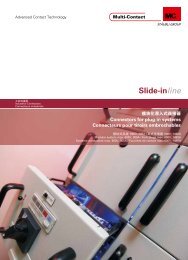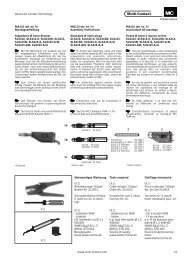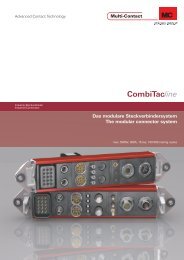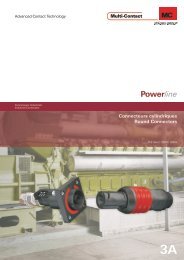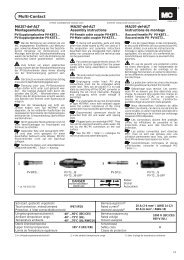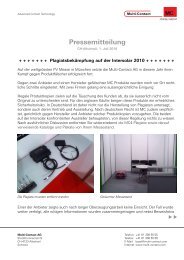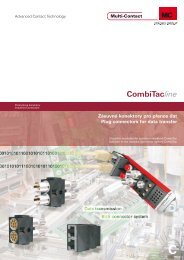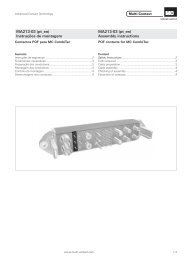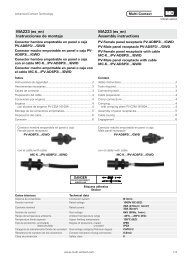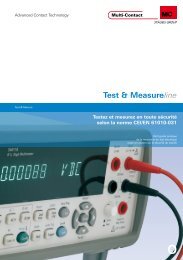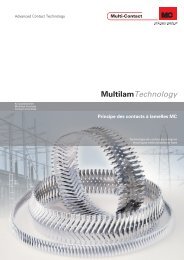Assembly instructions MA207 - Multi-Contact
Assembly instructions MA207 - Multi-Contact
Assembly instructions MA207 - Multi-Contact
Create successful ePaper yourself
Turn your PDF publications into a flip-book with our unique Google optimized e-Paper software.
Advanced <strong>Contact</strong> Technology<br />
MA000 <strong>MA207</strong> (de_en) (fr_en)<br />
Montageanleitung<br />
Notice de montage<br />
Raccord femelle PV-KBT3...<br />
Raccord mâle PV-KST3...<br />
Contenu<br />
Consignes de sécurité ................................................................2<br />
Outillage nécessaire ..................................................................3<br />
Câble de raccordement .............................................................4<br />
Préparation du câble ..................................................................4<br />
Raccords à sertir ........................................................................4<br />
Sertissage ..................................................................................5<br />
— avec la pince à sertir PV-CZM-16100A ...................................5<br />
— avec la pince à sertir PV-CZ ....................................................6<br />
Montage ....................................................................................6<br />
Disposition de câble ..................................................................8<br />
Connexion .................................................................................8<br />
* UL fi le E343181<br />
PV-T3.../B<br />
PV-T3.../B-UR*<br />
Données techniques Technical data<br />
MA000 <strong>MA207</strong> (de_en) (fr_en)<br />
<strong>Assembly</strong> <strong>instructions</strong><br />
PV-BP3/... PV-SP3/...<br />
Autocollant<br />
Sticker<br />
PV female cable coupler PV-KBT3...<br />
PV male cable coupler PV-KST3...<br />
Système de connexion Connector system Ø 3mm<br />
Tension assignée Rated voltage<br />
Courant assigné Rated current<br />
Content<br />
Safety Instructions ......................................................................2<br />
Tools required ............................................................................3<br />
Connecting cable .......................................................................4<br />
Cable preparation ......................................................................4<br />
Crimp connections ....................................................................4<br />
Crimping ....................................................................................5<br />
— with crimping pliers PV-CZM-16100A ....................................5<br />
— with crimping pliers PV-CZ .....................................................6<br />
<strong>Assembly</strong> ...................................................................................6<br />
Cable routing .............................................................................8<br />
Engagement ..............................................................................8<br />
1000V DC (IEC)<br />
600V DC (UL)<br />
PV-T3.../S<br />
PV-T3.../S-UR*<br />
20A (IEC: 2,5 – 4mm 2 )<br />
(UL: 14AWG, 12AWG)<br />
30A (IEC: 6mm 2 )<br />
(UL: 10AWG)<br />
Tension d‘essai Test voltage 6kV (50Hz, 1min.)<br />
Plage de la température ambiante Ambient temperature range<br />
-40°C...+90°C (IEC)<br />
-40°C...+75°C (UL)<br />
Température limite supérieure Upper limiting temperature 105°C (IEC)<br />
Degré de protection, branché<br />
non branché<br />
Catégorie de surtension<br />
Degré de pollution<br />
Résistance de contact des<br />
connecteurs<br />
Degree of protection, mated<br />
unmated<br />
Overvoltage category<br />
Pollution degree<br />
IP67<br />
IP2X<br />
CATIII/2<br />
<strong>Contact</strong> resistance of plug connectors 0,5mΩ<br />
Classe de protection Safety class II<br />
www.multi-contact.com 1 / 8
Advanced <strong>Contact</strong> Technology<br />
Consignes de sécurité Safety Instructions<br />
Le montage et l’installation des produits ne doivent être effectués<br />
que par du personnel qualifi é et formé en respectant<br />
toutes les dispositions de sécurité et réglementations légales<br />
applicables.<br />
<strong>Multi</strong>-<strong>Contact</strong> (MC) décline toute responsabilité en cas de<br />
non-respect de ces consignes.<br />
Utiliser uniquement les pièces et outils recommandés par MC.<br />
Suivre scrupuleusement les étapes de préparation et de montage<br />
décrites ici, faute de quoi ni la sécurité ni le respect des<br />
caractéristiques techniques ne sont garantis. Ne pas modifi er<br />
le produit d’une quelconque manière.<br />
Les connecteurs non fabriqués par MC qui sont enfi chables<br />
avec des éléments MC, et parfois qualifi és de «compatibles<br />
MC» par les fabricants, ne répondent pas aux exigences d’une<br />
liaison électrique sûre et stable à long terme. Ils ne doivent<br />
pas, pour des raisons de sécurité, être enfi chés dans des éléments<br />
MC. Nous déclinons par conséquent toute responsabilité<br />
si ces connecteurs non approuvés par MC sont utilisés<br />
avec des éléments MC et qu’il en résulte des dommages.<br />
Les travaux décrits ici ne doivent pas être effectués<br />
sur des parties parcourues par un courant ou sous<br />
tension.<br />
La protection contre les chocs électriques doit être<br />
assurée par le produit fi nal et garantie par l’utilisateur.<br />
Les connecteurs ne doivent pas être débranchés<br />
sous charge. L’embrochage et le débrochage sous<br />
tension sont permis.<br />
Les connecteurs non branchés doivent être protégés<br />
contre l’humidité et la saleté par un bouchon de<br />
fermeture (MC3 N° d’article 32.0720 pour douilles et<br />
32.0721 pour fi ches). Il est interdit d’embrocher des<br />
connecteurs encrassés.<br />
La connexion ne doit jamais être soumise à un effort<br />
de traction mécanique permanent. Le câble doit être<br />
fi xé au moyen de colliers.<br />
MC déconseille d’utiliser des câbles PVC ou des<br />
câbles non étamés du type H07RN-F.<br />
Pour des caractéristiques techniques détaillées, se<br />
reporter au catalogue des produits.<br />
2 / 8 www.multi-contact.com<br />
The products may be assembled and installed only by suitably<br />
qualifi ed and trained specialists with due observance of all applicable<br />
safety regulations.<br />
<strong>Multi</strong>-<strong>Contact</strong> (MC) declines any liability in the event of failure<br />
to observe these warnings.<br />
Use only the components and tools specifi ed by MC. Do not<br />
deviate from the preparation and assembly procedures described<br />
here, since in this event, in the event of self-assembly,<br />
no guarantee can be given as to safety or conformity with the<br />
technical data. Do not modify the product in any way.<br />
Connectors not made by MC which can be mated with MC<br />
elements and in some cases are also described as ”MC-compatible”<br />
do not conform to the requirements for safe electrical<br />
connection with long-term stability, and for safety reasons<br />
must not be plugged together with MC elements. MC can<br />
therefore accept no liability for damage which occurs as a result<br />
of mating these connectors which lack MC approval with<br />
MC elements.<br />
The work described here must not be carried out<br />
on live or load-carrying parts.<br />
Protection from electric shock must be assured by<br />
the end product and its user.<br />
The plug connections must not be disconnected<br />
under load. Plugging and unplugging when live is<br />
permitted.<br />
Unmated plug connectors must be protected from<br />
moisture and dirt with a sealing cap (MC3 Article<br />
No. 32.0720 sockets and 32.0721 for plugs). The<br />
male and female parts must not be plugged together<br />
when soiled.<br />
The plug connection must not be subjected to<br />
continuous mechanical tension. The cable should be<br />
fi xed with cable binders.<br />
MC does not recommend the use of either PVC cables<br />
or untinned cables of type H07RN-F.<br />
For further technical data please see the product<br />
catalogue.<br />
Explication des symboles Explanation of the symbols<br />
Mise en garde contre une tension électrique dangereuse<br />
Warning of dangerous voltages<br />
Mise en garde contre un danger Warning of a hazard area<br />
Remarque ou conseil utile Useful hint or tip
Advanced <strong>Contact</strong> Technology<br />
PV-CZ<br />
UL fi le 343181<br />
Localisateur<br />
Locator<br />
PV-CZM-16100A<br />
UL File 343181<br />
1<br />
2<br />
2<br />
Outillage nécessaire Tools required<br />
(ill. 1)<br />
Pince à dénuder PV-AZM... avec<br />
couteaux à dénuder ainsi qu‘une clé à<br />
6 pans 2,5.<br />
Section du câble: 1,5 / 2,5 / 4 / 6mm²<br />
Type: PV-AZM-1.5/6<br />
No. de Cde.: 32.6029-156<br />
(ill. 2)<br />
Pince à sertir PV-CZM-16100A pour<br />
section de câble<br />
2,5mm² – 6mm² (14 / 12AWG)<br />
No. de Cde.: 32.6020-16100A<br />
Remarque:<br />
pour l‘utilisation de la pince à sertir,<br />
voir MA251<br />
(www.multi-contact.com).<br />
ou<br />
Pince à sertir PV-CZ pour section de<br />
câble 2,5mm² à 4mm²<br />
No. de Cde.: 32.6008<br />
(ill. 3)<br />
Outil de montage PV-RWZ3 avec 2<br />
cônes inclus<br />
No. de Cde.: 32.6021-16100<br />
1<br />
Tige de traction<br />
Pull rod<br />
2<br />
Levier anti retour<br />
Reset lever<br />
3<br />
Pos. Type<br />
Levier de manoeuvre<br />
Operating lever<br />
No.de Cde<br />
Order No.<br />
Cônes<br />
Tapered spindle<br />
Désignation Description<br />
(ill. 1)<br />
Stripping pliers PV-AZM... incl.<br />
built-in wire stripping blade as well as<br />
hexagonal screwdriver A/F 2,5mm.<br />
Cable cross section: 1,5 / 2,5 / 4 / 6mm²<br />
Type: PV-AZM-1.5/6<br />
Order No.: 32.6029-156<br />
(ill. 1)<br />
Crimping pliers PV-CZM-16100A for<br />
cable cross section of<br />
2,5mm² – 6mm² (14 / 12AWG)<br />
Order No.: 32.6020-16100A<br />
Notes:<br />
to the operation of the crimping<br />
pliers, see MA251<br />
(www.multi-contact.com)<br />
or<br />
Crimping pliers PV-CZ for cable cross<br />
section of 2,5mm² and 4mm²<br />
Order No.: 32.6008<br />
(ill. 3)<br />
<strong>Assembly</strong> device PV-RWZ3 incl. 2<br />
tapered spindles<br />
Order No.: 32.6021-16100<br />
1 + 2 + 3 PV-RWZ3 32.6050 Outil de montage avec 2 cônes inclus <strong>Assembly</strong> device incl. 2 tapered spindles<br />
Pièces détachées Individual parts<br />
1 PV-R-RWZ3 32.6051 Outil de montage <strong>Assembly</strong> device<br />
2 PV-KO3 I+II 32.6052 Cône pour isolants de tailles I + II Tapered spindle for insulators size I + II<br />
3 PV-KO3 III 32.6053 Cône pour isolants de taille III Tapered spindle for insulators size III<br />
www.multi-contact.com 3 / 8<br />
3
Advanced <strong>Contact</strong> Technology<br />
Tab. 1<br />
Taille<br />
Size<br />
Tab. 2<br />
Type<br />
L<br />
G<br />
Longueur L (mm)<br />
Length L (mm)<br />
PV-BP3/4 6 – 7,5<br />
PV-SP3/4 6 – 7,5<br />
PV-BP3/6 8,5 – 9,5<br />
PV-SP3/6 8,5 – 9,5<br />
H<br />
G (mm) H (mm)<br />
I 2,8 3,2 – 4,8<br />
II 4 4,9 – 7,1<br />
III 6 6,5 – 9<br />
4 / 8 www.multi-contact.com<br />
4<br />
5<br />
Câbles de raccordement Connecting cable<br />
(ill. 4 / Tab. 1)<br />
Pour s’assurer de l’étanchéité du<br />
connecteur PV avec le câble:<br />
L’utilisation de conducteurs multibrins<br />
en dimensions AWG est possible.<br />
Vérifi ez le diamètre G du passe-câble<br />
pour le diamètre de câble H d’après<br />
l’illustration 4 et le tableau 1.<br />
Attention:<br />
Assurez-vous, lors de la sélection<br />
de câbles de raccordement à<br />
double isolation, qu’il existe une<br />
adhérence suffi sante entre les<br />
couches isolantes. Dans le cas<br />
contraire, les couches isolantes<br />
pourraient se déplacer l’une par<br />
rapport à l’autre ou par rapport<br />
au conducteur.<br />
(ill. 4 / Tab. 1)<br />
Ensure that there is a tight seal between<br />
the male PV coupler and the<br />
cable:<br />
It is possible to use multiple-wire<br />
cables in AWG dimensions.<br />
Check on the basis of illustration 4<br />
and table 1 that the lead-through G<br />
has the correct diameter for the cable.<br />
Attention:<br />
When choosing double-insulated<br />
connecting leads, take care that<br />
there is suffi cient adhesion between<br />
the layers of insulation.<br />
If this is not the case, the layers<br />
can slide over each other or shift<br />
on the conductor.<br />
Préparation du câble Cable preparation<br />
Les câbles de raccordement de classe<br />
de souplesse 5 et 6 peuvent être<br />
raccordés.<br />
Attention:<br />
Ne pas utiliser des conducteurs<br />
nus ou déjà oxydés. Les conducteurs<br />
étamés sont avantageux.<br />
Tous les câbles solaires de MC<br />
sont fabriqués avec des conducteurs<br />
étamés de grande qualité.<br />
(ill. 5)<br />
Dénuder le câble.<br />
Longueur selon Tab. 2.<br />
Attention:<br />
Veillez à ne pas couper les brins<br />
lors de la dénudation.<br />
Remarque:<br />
Pour l’utilisation de la pince à<br />
dénuder PV-AZM... ainsi que pour le<br />
remplacement de jeux de couteaux,<br />
reportez-vous à la notice d’utilisation<br />
MA267 sur www.multi-contact.com<br />
For TÜV certifi ed assembly cables<br />
with a strand construction of classes 5<br />
and 6 must be connected.<br />
Attention:<br />
Use no uncoated or already oxidised<br />
conductors. It is advantage<br />
to use tinned conductors. All MC<br />
solar cables have high-quality,<br />
tinned conductors.<br />
(ill. 5)<br />
Strip cable insulation.<br />
Length according to Tab. 2.<br />
Attention:<br />
Do not cut individual strands at<br />
stripping.<br />
Note:<br />
For directions on the use of stripping<br />
pliers PV-AZM... and changing<br />
blade sets, see operating instruction<br />
MA267 at www.multi-contact.com<br />
Raccords à sertir Crimp connections<br />
Pour le raccordement des conducteurs<br />
aux fûts à sertir des connecteurs<br />
PV, nous recommandons l’emploi des<br />
outils de sertissage indiqués. Les fûts<br />
à sertir sont conçus pour des conducteurs<br />
souples (classe 5 et 6 selon CEI<br />
60228, DIN VDE 0295) de sections<br />
2,5mm² à 10mm².<br />
For connecting the conductors to the<br />
crimp sleeves of the PV couplers, we<br />
recommend using the stated crimping<br />
tools. The crimping sleeves are designed<br />
for fl exible wires (classes 5 and<br />
6 according to IEC 60228, DIN VDE<br />
0295) with conductor cross-sections<br />
of 2,5mm² to 10mm².
Advanced <strong>Contact</strong> Technology<br />
S<br />
max. 1 mm<br />
6<br />
7<br />
8<br />
Sertir Crimping<br />
avec la pince à sertir<br />
PV-CZM-16100A<br />
pour section de câble 2,5mm²,<br />
4mm² et 6mm²<br />
Cette pince à sertir dispose de matrices<br />
de sertissage interchangeables<br />
pour les plages de section de câble<br />
suivantes:<br />
1) 2,5 / 4 / 6mm 2 (14 / 12 / 10AWG)<br />
2) 4 / 10mm 2 (12AWG)<br />
Dans la description suivante du processus<br />
de sertissage, on a utilisé des<br />
images pour la plage de sections (1).<br />
Le processus de sertissage est identique<br />
pour la plage de sections (2).<br />
Pour d’autres indications sur l’utilisation<br />
de la pince à sertir, pour le<br />
remplacement des matrices de sertissage<br />
ainsi que le positionneur correspondant,<br />
reportez-vous à la notice<br />
d’utilisation MA251 sur<br />
www.multi-contact.com<br />
(ill. 6)<br />
Introduisez la partie métallique de la<br />
douille ou de la fi che dans le guide<br />
pour la section correspondante. Introduisez<br />
le câble jusqu’en butée dans<br />
le fût à sertir. Maintenez le câble dans<br />
le fût.<br />
(ill. 7)<br />
Attention:<br />
Tous les brins du câble doivent<br />
être introduits proprement dans<br />
le trou et être visibles dans l‘orifi<br />
ce de contrôle S. La distance<br />
maximale de 1mm ne doit pas<br />
être dépassée.<br />
with crimping pliers<br />
PV-CZM-16100A<br />
for cable cross section 2,5mm²,<br />
4mm² and 6mm²<br />
This crimping tool is equipped with interchangeable<br />
crimping inserts for the<br />
following wire cross-section ranges:<br />
1) 2,5 / 4 / 6mm 2 (14 / 12 / 10AWG)<br />
2) 4 / 10mm 2 (12AWG)<br />
In the following description of the<br />
crimping process, illustrations from<br />
cross section range (1) have been<br />
used. The crimping procedure for<br />
cross-section range (2) is identical.<br />
For further hints on the operation of<br />
the crimping tool and for changing the<br />
crimping inserts and the appropriate<br />
locators, please see operating instruction<br />
MA251 at<br />
www.multi-contact.com<br />
(ill. 6)<br />
Place the metal part of the female<br />
or male coupler in the guide for the<br />
appropriate cross section. Insert the<br />
wire into the crimping sleeve as far as<br />
it will go. Hold the wire in place in the<br />
sleeve.<br />
(ill. 7)<br />
Attention:<br />
All strands of the wires must be<br />
correctly inserted into the borehole<br />
and visible in sight hole S.<br />
The max. distance of 1mm must<br />
not be exceeded.<br />
Fermez complètement la pince à sertir. Completely close the crimping tool.<br />
(ill. 8)<br />
Contrôlez le sertissage visuellement.<br />
(ill. 8)<br />
Visually check the crimp.<br />
www.multi-contact.com 5 / 8
Advanced <strong>Contact</strong> Technology<br />
S<br />
max. 1 mm<br />
Industriealkohol<br />
Industrial alcohol<br />
alcool industriel<br />
6 / 8 www.multi-contact.com<br />
9<br />
9<br />
10<br />
11<br />
12<br />
avec la pince à sertir PV-CZ<br />
pour sections de câble 2,5mm² et<br />
4mm²<br />
(ill. 9)<br />
Introduisez la partie métallique de la<br />
douille ou de la fi che dans le guide<br />
pour la section correspondante. Introduisez<br />
le câble jusqu’en butée dans<br />
le fût à sertir. Maintenez le câble dans<br />
le fût.<br />
(ill. 10)<br />
Attention:<br />
Tous les brins du câble doivent<br />
être introduits proprement dans<br />
le trou et être visibles dans l‘orifi<br />
ce de contrôle S. La distance<br />
maximale de 1mm ne doit pas<br />
être dépassée.<br />
Fermez complètement la pince à sertir.<br />
(ill. 11)<br />
Contrôlez le sertissage visuellement.<br />
with crimping pliers PV-CZ<br />
for cable cross section 2,5mm²<br />
and 4mm²<br />
(ill. 9)<br />
Place the metal part of the female<br />
or male coupler in the guide for the<br />
appropriate cross section. Insert the<br />
wire into the crimping sleeve as far as<br />
it will go. Hold the wire in place in the<br />
sleeve.<br />
(ill. 10)<br />
Attention:<br />
All strands of the wires must be<br />
correctly inserted into the borehole<br />
and visible in sight hole S.<br />
The max. distance of 1mm must<br />
not be exceeded.<br />
Completely close the crimping tool.<br />
(ill. 11)<br />
Visually check the crimp.<br />
Montage <strong>Assembly</strong><br />
(ill. 12)<br />
Remarque:<br />
L’emmanchement des contacts<br />
peut être facilité en plongeant au<br />
préalable des corps isolants dans de<br />
l’alcool industriel.<br />
(ill. 12)<br />
Note:<br />
You can facilitate the assembly procedure<br />
by immersing the connector<br />
insulators in industrial alcohol before<br />
inserting the contacts.
Advanced <strong>Contact</strong> Technology<br />
PV-KO3 I+II<br />
40mm min.<br />
Rainures / Grooves<br />
13<br />
14<br />
15<br />
16<br />
17<br />
18<br />
19<br />
(ill. 13)<br />
Tenez l’outil de montage par la partie<br />
avant. Poussez le levier de rappel R<br />
dans la direction de la fl èche avec le<br />
pouce et poussez simultanément la<br />
tige de traction Z jusqu’en butée avec<br />
l’autre main.<br />
(ill. 14)<br />
Selectionnez le cône:<br />
• PV-KO3 I+II pour isolations de<br />
douille et fi che de tailles I et II<br />
• PV-KO3 III pour isolations de douille<br />
et fi che de taille III<br />
Pousser le cône par l’arrière à travers<br />
l’isolation de douille ou de fi che<br />
jusqu’à ce que la tige de traction<br />
dépasse de 40mm.<br />
(ill. 15)<br />
Introduisez la douille ou la fi che avec<br />
le câble serti dans le cône.<br />
(ill. 16)<br />
Introduisez le cône dans l’outil de<br />
montage et accrochez-le au support<br />
de cône tout en maintenant la tige de<br />
traction.<br />
(ill. 17)<br />
Actionnez plusieurs fois la poignée<br />
de l’outil pour tirer le cône à travers<br />
l’entrée de l’outil tout en maintenant<br />
le câble avec une légère pression dans<br />
le cône, jusqu’à ce que la fi che ou la<br />
douille s’enclenche dans l’isolation.<br />
Retirez complètement le cône de<br />
l’isolation.<br />
(ill. 18)<br />
Retirez la douille ou la fi che de l’appareil<br />
de montage.<br />
(ill. 19)<br />
Ramenez la tige de traction Z en<br />
arrière.<br />
Sortez le cône K de l’appareil de<br />
montage.<br />
(ill. 13)<br />
Hold the assembly tool by the pull-in<br />
tube.<br />
Press the return lever R with the<br />
thumb in the direction of the arrow<br />
and at the same time press in the<br />
puller rod Z to the limit with the other<br />
hand.<br />
(ill. 14)<br />
Select the appropriate tapered spindle:<br />
• PV-KO3 I+II for male and female<br />
coupler insulators of sizes I and II<br />
• PV-KO3 III for male and female coupler<br />
insulators of size III<br />
Push the tapered spindle from behind<br />
into the male or female insulator until<br />
the puller rod protrudes from the male<br />
or female insulator by approx. 40mm.<br />
(ill. 15)<br />
Insert the male or female coupler<br />
with crimped-on lead into the tapered<br />
spindle.<br />
(ill. 16)<br />
Insert the tapered spindle into the<br />
assembly tool and attach it to the<br />
spindle holder. During this operation<br />
hold the puller rod in position.<br />
(ill. 17)<br />
Actuate the handle of the tool several<br />
times. This pulls the tapered spindle<br />
through the infeed opening of the<br />
tool. Apply gentle pressure to keep<br />
the lead in the spindle until the male<br />
or female coupler part engages in<br />
the insulator. Pull the tapered spindle<br />
completely out of the insulator.<br />
(ill. 18)<br />
Withdraw the male or female coupler<br />
from the assembly tool.<br />
(ill. 19)<br />
Return the puller rod Z to its starting<br />
position.<br />
Remove the tapered spindle K from<br />
the assembly tool.<br />
www.multi-contact.com 7 / 8
Advanced <strong>Contact</strong> Technology<br />
20<br />
21<br />
(ill. 20)<br />
Assurez-vous que le passe-câble est<br />
correctement enclenché sur la partie<br />
métallique en tirant légèrement sur le<br />
câble.<br />
Pour être correctement montées, les<br />
pièces doivent être à fl eur de la face<br />
avant de l’isolation.<br />
(ill. 21)<br />
Coller l’autocollant„DANGER – DO<br />
NOT DISCONNECT UNDER LOAD“ à<br />
proximité du raccord mâle PV.<br />
Disposition de câble Cable routing<br />
Se référer aux spécifi cations du<br />
fabricant de câbles pour un rayon de<br />
courbure minimal.<br />
(ill. 20)<br />
Pull gently on the lead to check that<br />
the sleeve is correctly locked in place<br />
on the metal part.<br />
If it is correcly located, the fi tted parts<br />
must be fl ush with the front face of<br />
the insulator.<br />
(ill. 21)<br />
Affi x the supplied sticker “DANGER<br />
– DO NOT DISCONNECT UNDER<br />
LOAD” in the vicinity of the PV coupler.<br />
Refer to cable manufactures specifi cation<br />
for minimum bending radius.<br />
alterations<br />
to Subject / réserve sous<br />
Connexion Engagement<br />
cations<br />
Assurez-vous que les connecteurs Check that the coupler parts are fully<br />
sont complètement fermés.<br />
engaged.<br />
Modifi – Communications Global , l index 02.2012, – <strong>MA207</strong> –<br />
Fabricant/Producer:<br />
Switzerland<br />
<strong>Multi</strong>-<strong>Contact</strong> AG<br />
AG,<br />
Stockbrunnenrain 8<br />
CH – 4123 Allschwil<br />
Tel. +41/61/306 55 55<br />
Fax +41/61/306 55 56<br />
<strong>Multi</strong>-<strong>Contact</strong><br />
mail basel@multi-contact.com<br />
by<br />
www.multi-contact.com ©



